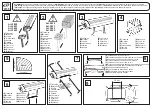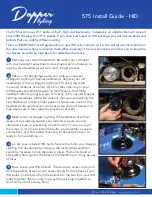
CAUTION!
When driving through water, do not exceed
5 mph (8 km/h). Always check water depth
before entering, as a precaution, and check all
fluids afterward. Driving through water may
cause damage that may not be covered by the
new vehicle limited warranty.
Driving through water more than a few inches/
centimeters deep will require extra caution to
ensure safety and prevent damage to your
vehicle. If you must drive through water, try to
determine the depth and the bottom condition
(and location of any obstacles) prior to entering.
Proceed with caution and maintain a steady
controlled speed less than 5 mph (8 km/h) in
deep water to minimize wave effects.
Flowing Water
If the water is swift flowing and rising (as in
storm run-off), avoid crossing until the water
level recedes and/or the flow rate is reduced. If
you must cross flowing water avoid depths in
excess of 9 inches (23 cm). The flowing water
can erode the streambed, causing your vehicle
to sink into deeper water. Determine exit
point(s) that are downstream of your entry point
to allow for drifting.
Standing Water
Avoid driving in standing water deeper than
20 inches (51 cm), and reduce speed appropri-
ately to minimize wave effects. Maximum speed
in 20 inches (51 cm) of water is less than 5 mph
(8 km/h).
Maintenance
After driving through deep water, inspect your
vehicle fluids and lubricants (engine oil, trans-
mission oil, axle, transfer case) to assure the
fluids have not been contaminated. Contami-
nated fluid (milky, foamy in appearance) should
be flushed/changed as soon as possible to
prevent component damage.
Driving In Snow, Mud And Sand
In heavy snow, when pulling a load, or for
additional control at slower speeds, shift the
transmission to a low gear and shift the transfer
case to 4WD LOW if necessary. Refer to “Four-
Wheel Drive Operation” in “Starting and Oper-
ating” for further information. Do not shift to a
lower gear than necessary to maintain forward
motion. Over-revving the engine can spin the
wheels and traction will be lost.
Avoid abrupt downshifts on icy or slippery roads,
because engine braking may cause skidding and
loss of control.
Hill Climbing
NOTE:
Before attempting to climb a hill, determine
the conditions at the crest and/or on the
other side.
Before climbing a steep hill, shift the trans-
mission to a lower gear and shift the transfer
case to 4WD LOW. Use first gear and 4WD
LOW for very steep hills.
246
Summary of Contents for 2013 Grand Cherokee
Page 1: ...Grand Cherokee O P E R AT I N G I N F O R M AT I O N...
Page 2: ......
Page 3: ......
Page 4: ......
Page 6: ...2...
Page 11: ...7...
Page 66: ...62...
Page 91: ...87...
Page 92: ...88...
Page 93: ...89...
Page 165: ...INSTRUMENT CLUSTER 161...
Page 187: ...Compass Variance Map 183...
Page 218: ...Operating Tips Chart 214...
Page 296: ...292...
Page 372: ...368...
Page 395: ...391...
Page 396: ...392...
Page 397: ...10 INDEX 393...
Page 407: ......
Page 408: ...Chrysler Group LLC 13WK741 126 ENG AB Printed in Europe 13...
















































